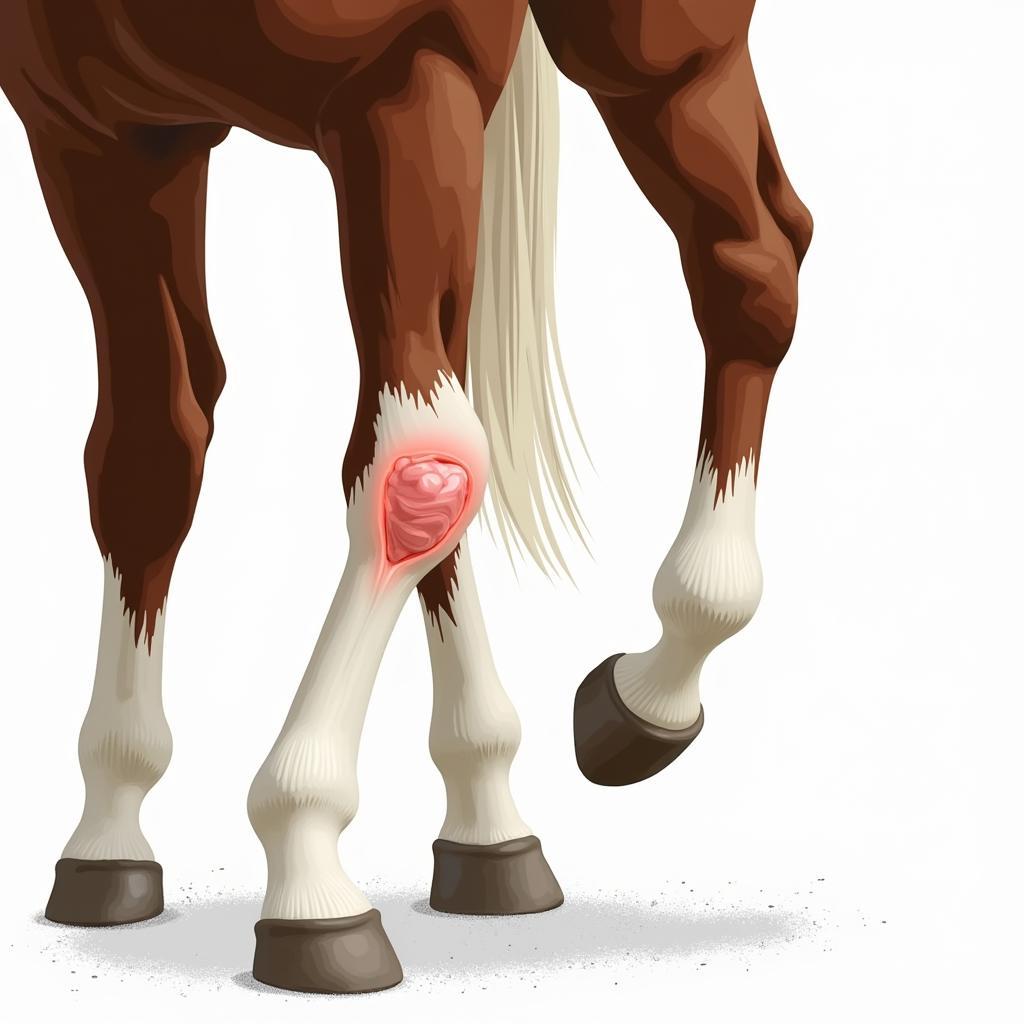Horse Tendon Injuries are a significant concern for horse owners, impacting a horse’s performance and overall well-being. From minor strains to severe ruptures, understanding the nuances of these injuries is crucial for effective treatment and rehabilitation. This article will delve into the complexities of horse tendon injuries, providing valuable insights into their causes, diagnosis, and management.
The Common Culprits Behind Horse Tendon Injuries
Tendons, the tough, fibrous cords connecting muscle to bone, are vulnerable to injury due to the high stresses they endure during exercise. Overexertion, improper training techniques, and poor footing are common culprits. A sudden increase in workload or intensity can strain the tendons, leading to inflammation and pain. Similarly, uneven terrain or deep, heavy footing can place undue stress on the horse’s legs, increasing the risk of injury. Pre-existing conditions, such as poor conformation or previous injuries, can also predispose a horse to tendon problems. Early detection and intervention are key to preventing long-term complications.
 Horse Tendon Injury Due to Overexertion
Horse Tendon Injury Due to Overexertion
Diagnosing Horse Tendon Injuries: A Multifaceted Approach
Diagnosing a horse tendon injury requires a thorough examination by a veterinarian. Palpation of the affected area often reveals heat, swelling, and pain. Diagnostic imaging techniques, such as ultrasound, provide detailed images of the tendon, allowing veterinarians to assess the extent of the damage. Ultrasound helps pinpoint the location and severity of the injury, differentiating between strains, tears, and ruptures. Sometimes, other diagnostic tools, such as MRI or CT scans, may be necessary for a more comprehensive evaluation.
Effective Treatment and Rehabilitation Strategies for Horse Tendon Injuries
Treatment options vary depending on the severity of the injury. For minor strains, rest and cold therapy are often sufficient to reduce inflammation and promote healing. More severe injuries may require additional interventions, such as controlled exercise, medications, horse mesotherapy, or even surgery. “Early intervention is paramount,” advises Dr. Emily Carter, DVM, “Prompt diagnosis and treatment significantly improve the chances of a full recovery.”
extensor tendon horse injuries are particularly challenging.
What are the different types of horse tendon injuries?
The most common types of horse tendon injuries include strains, tears, and ruptures. Strains involve stretching or minor tearing of tendon fibers, while tears represent more significant damage. Ruptures are complete breaks in the tendon, requiring extensive treatment and rehabilitation.
How can horse tendon injuries be prevented?
Preventive measures include proper conditioning, gradual increases in workload, regular farrier care, and the use of appropriate horse leg protectors. Maintaining good footing and avoiding overexertion are crucial for preventing tendon injuries.
Long-term Management of Horse Tendon Injuries
Following initial treatment, rehabilitation plays a crucial role in restoring tendon function and preventing re-injury. A carefully designed rehabilitation program, often involving controlled exercise and physical therapy, is essential for a successful outcome. “Patience is key during the rehabilitation process,” says Dr. John Miller, Equine Surgeon, “It’s important to allow adequate time for the tendon to heal properly before returning the horse to full work.” common digital extensor tendon horse injuries often require prolonged rehabilitation. Check out cayley wilson performance horses for more information.
Horse tendon injuries can be a significant setback, but with proper management, many horses can return to their previous level of activity. Understanding the causes, diagnosis, and treatment options for horse tendon injuries empowers horse owners to make informed decisions and provide the best possible care for their equine companions. By prioritizing early intervention and adhering to a comprehensive rehabilitation plan, horse owners can maximize their horse’s chances of a full recovery.
FAQ
- What are the signs of a horse tendon injury?
- How are horse tendon injuries diagnosed?
- What are the treatment options for horse tendon injuries?
- How long does it take for a horse tendon injury to heal?
- What is the prognosis for a horse with a tendon injury?
- How can horse tendon injuries be prevented?
- What are the long-term management strategies for horse tendon injuries?
For further assistance, please contact us: Phone: 0772127271, Email: [email protected], or visit us at QGM2+WX2, Vị Trung, Vị Thuỷ, Hậu Giang, Vietnam. We offer 24/7 customer support.